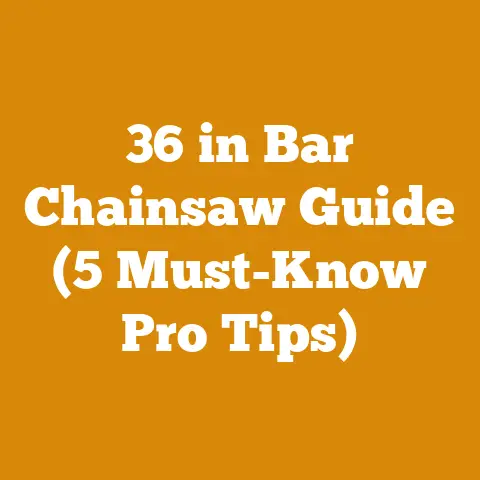Can I Run .063 Gauge Chains on Stihl? (5 Expert Tips)
Let’s bust a myth right off the bat. I often hear folks saying, “Chain gauge doesn’t really matter as long as the chain fits the bar.” Hogwash! While a .050″ gauge chain might technically fit on a .063″ gauge bar (or vice versa), running the wrong gauge chain is a recipe for disaster. It’s like putting the wrong size tires on your truck – it might roll, but you’re sacrificing performance, safety, and longevity.
The user intent behind the question “Can I Run .063 Gauge Chains on Stihl? (5 Expert Tips)” is clear: someone wants to know if they can use a .063″ gauge chainsaw chain on their Stihl chainsaw, and they’re looking for expert advice on the implications. They likely have a Stihl saw, are considering a different chain gauge, or are unsure about compatibility. They probably want to understand the risks, benefits, and potential workarounds.
Understanding Chainsaw Chain Gauge: The Foundation for Compatibility
Before we get into the specifics of Stihl chainsaws and .063″ gauge chains, let’s define what chain gauge actually is.
Chain gauge refers to the drive link thickness of the chainsaw chain. It’s the measurement of the part of the chain that fits into the groove of the chainsaw bar. Gauge is typically measured in thousandths of an inch. Common gauges include .043″, .050″, .058″, and .063″.
Think of it like this: the chainsaw bar groove is a road, and the drive links are the wheels of a car. If the wheels are too narrow for the road, the car will wobble and be unstable. If the wheels are too wide, they won’t fit on the road at all.
Why is gauge so important?
- Proper Fit: The correct gauge ensures the chain fits snugly in the bar groove, providing stability and preventing the chain from derailing.
- Oil Delivery: The gauge also affects how efficiently the chain oil is delivered to the cutting parts of the chain. An incorrect gauge can hinder oil flow, leading to premature wear and tear.
- Cutting Performance: A properly fitted chain runs smoother, cuts more efficiently, and reduces vibration.
Common Gauges and Their Typical Uses:
- .043″ Gauge: Typically found on smaller, homeowner-grade chainsaws. These saws are usually used for light-duty tasks like pruning and limbing.
- .050″ Gauge: The most common gauge, found on a wide range of chainsaws from homeowner models to professional-grade saws. A versatile option for general-purpose cutting.
- .058″ Gauge: Often found on professional-grade chainsaws designed for felling larger trees and heavy-duty cutting.
- .063″ Gauge: Primarily used on larger, more powerful professional chainsaws. This gauge provides increased durability and stability for demanding cutting applications.
A Personal Anecdote:
I remember one time, early in my wood processing career, I tried to get away with using a .050″ gauge chain on a bar designed for .058″. It seemed to fit okay, but the chain kept jumping off the bar, especially when I was trying to fell a large oak. After several frustrating attempts and near-miss accidents, I finally realized my mistake.
Tip #1: Check Your Stihl Chainsaw’s Specifications
The most crucial step is to determine the correct chain gauge for your specific Stihl chainsaw model. Stihl, like other reputable manufacturers, designs its saws to operate with a specific chain gauge for optimal performance and safety.
Where to Find the Information:
- Owner’s Manual: This is the first place you should look. The owner’s manual will clearly state the recommended chain gauge (and other chain specifications like pitch and number of drive links) for your saw.
- Chainsaw Bar: Many chainsaw bars have the recommended chain gauge stamped directly on them. Look closely at the base of the bar, near where it mounts to the saw.
- Stihl Website: The Stihl website has a wealth of information about their products, including detailed specifications for each chainsaw model. You can usually find the information by searching for your saw model on their website.
- Local Stihl Dealer: If you’re unsure, visit your local Stihl dealer. They can quickly identify your saw model and provide you with the correct chain specifications.
Example:
Let’s say you own a Stihl MS 271 Farm Boss chainsaw. Consulting the owner’s manual, you’ll find that it’s typically designed to use a .063″ gauge chain. However, some MS 271 models may be configured for .050″ gauge, depending on the bar length and region of sale. Always double-check to be sure.
Why This Matters:
Using the wrong gauge chain can lead to:
- Chain Derailment: The chain is more likely to jump off the bar, posing a serious safety hazard.
- Premature Wear: The chain and bar will wear out faster due to improper fit and increased friction.
- Reduced Cutting Performance: The saw will not cut as efficiently, requiring more effort and increasing the risk of kickback.
- Damage to the Saw: In severe cases, using the wrong gauge chain can damage the drive sprocket or other components of the chainsaw.
Case Study: The MS 291 Debacle
I had a friend, Mark, who bought a used Stihl MS 291. He assumed it used the same .050″ gauge chain as his old saw. He started experiencing frequent chain derailments and poor cutting performance. After some troubleshooting, we discovered that his MS 291 was actually designed for a .063″ gauge chain. Switching to the correct gauge solved all the problems and restored the saw to its full performance potential. This highlights the importance of verifying the correct specifications, even if you think you know what you’re doing.
Tip #2: Understanding Chain Pitch and Drive Link Count
While chain gauge is crucial, it’s not the only factor to consider when selecting a chainsaw chain. You also need to understand chain pitch and drive link count.
Chain Pitch:
Chain pitch refers to the distance between any three consecutive rivets on the chain, divided by two. It’s typically measured in inches. Common pitches include 3/8″ (0.375″) and .325″.
Drive Link Count:
The drive link count is the number of drive links on the chain. This number is specific to the bar length.
How They Relate to Gauge:
- Pitch and Gauge are Independent: Pitch and gauge are independent measurements. You can have a .050″ gauge chain with a 3/8″ pitch or a .325″ pitch.
- Drive Link Count is Dependent on Bar Length: The drive link count is determined by the length of the chainsaw bar. A longer bar will require a chain with more drive links.
Why They Matter:
- Pitch Compatibility: The chain pitch must match the sprocket on the chainsaw. Using the wrong pitch will prevent the chain from engaging with the sprocket properly.
- Drive Link Count Compatibility: Using a chain with the wrong drive link count will result in a chain that is either too loose or too tight on the bar.
Finding the Right Pitch and Drive Link Count:
- Owner’s Manual: The owner’s manual will specify the recommended chain pitch and drive link count for your saw and bar combination.
- Chainsaw Bar: The bar may also have the recommended chain pitch and drive link count stamped on it.
- Counting Drive Links: You can manually count the drive links on your existing chain to determine the correct number.
Example:
Let’s say your Stihl MS 271 Farm Boss chainsaw has a 20″ bar. The owner’s manual might specify a 3/8″ pitch chain with 72 drive links. You would then need to purchase a chain with those specific specifications.
A Word of Caution:
Never assume that all chains with the same pitch and gauge will fit your saw. Always verify the drive link count to ensure a proper fit.
Tip #3: The Bar’s Role in Chain Compatibility
The chainsaw bar plays a critical role in chain compatibility. The bar groove width must match the chain gauge. If the groove is too wide, the chain will wobble and be unstable. If the groove is too narrow, the chain won’t fit at all.
Checking Bar Gauge:
- Stamped on the Bar: As mentioned earlier, most chainsaw bars have the gauge stamped directly on them. Look for a number like “.050” or “.063” near the base of the bar.
- Measuring the Groove: You can use a set of calipers to measure the width of the bar groove. This is a more precise method, but it requires the right tools.
Can You Change the Bar to Accommodate a Different Gauge Chain?
Yes, you can change the bar to accommodate a different gauge chain. However, there are a few things to consider:
- Sprocket Compatibility: The drive sprocket on your chainsaw must be compatible with the chain pitch you intend to use. If you change the chain pitch, you may also need to change the sprocket.
- Oil Delivery: A different gauge chain may require a different oil delivery system. Ensure that the bar you choose provides adequate lubrication for the chain you intend to use.
- Saw Power: Using a larger gauge chain may require more power from the saw. If your saw is already underpowered, switching to a larger gauge chain may further reduce its performance.
When Changing the Bar Makes Sense:
- Upgrading to a More Powerful Saw: If you’re upgrading to a more powerful chainsaw, you may want to switch to a larger gauge chain for increased durability and stability.
- Specialized Cutting Applications: Certain cutting applications, such as milling, may benefit from a larger gauge chain.
When to Avoid Changing the Bar:
- If Your Saw is Already Optimized: If your saw is already performing well with the current bar and chain combination, there’s no need to change it.
- If You’re Unsure About Compatibility: If you’re not sure about the compatibility of different bars and chains, consult with a qualified chainsaw technician.
My Personal Experience with Bar Swaps:
I’ve swapped chainsaw bars many times over the years, primarily to accommodate different cutting needs. For example, I use a longer bar with a .063″ gauge chain for felling large trees, and a shorter bar with a .050″ gauge chain for limbing and pruning. However, I always make sure to choose bars and chains that are compatible with my saws and that provide adequate lubrication.
Tip #4: The Pros and Cons of Using a .063″ Gauge Chain
Let’s delve deeper into the specific advantages and disadvantages of using a .063″ gauge chain.
Pros of .063″ Gauge Chains:
- Increased Durability: .063″ gauge chains are generally more durable than smaller gauge chains. The thicker drive links are less likely to break or stretch, especially under heavy use.
- Improved Stability: The wider drive links provide greater stability in the bar groove, reducing vibration and improving cutting accuracy.
- Better for Abrasive Conditions: .063″ gauge chains are better suited for cutting in abrasive conditions, such as when cutting dirty or sandy wood. The thicker drive links are more resistant to wear and tear.
- Ideal for Larger Saws: .063″ gauge chains are typically used on larger, more powerful chainsaws. These saws have the power to drive the heavier chain and take advantage of its increased durability and stability.
Cons of .063″ Gauge Chains:
- Requires More Power: .063″ gauge chains require more power to operate than smaller gauge chains. If your saw is underpowered, it may struggle to drive the chain effectively.
- Heavier: .063″ gauge chains are heavier than smaller gauge chains. This can lead to increased fatigue, especially when using the saw for extended periods.
- Slower Cutting Speed: Due to their increased weight and power requirements, .063″ gauge chains may have a slightly slower cutting speed than smaller gauge chains.
- Not Suitable for Smaller Saws: .063″ gauge chains are not suitable for smaller, homeowner-grade chainsaws. These saws typically lack the power and bar groove width required to operate a .063″ gauge chain effectively.
When a .063″ Gauge Chain is the Right Choice:
- You Have a Large, Powerful Chainsaw: If you own a professional-grade chainsaw with sufficient power, a .063″ gauge chain can be a great option for heavy-duty cutting.
- You’re Cutting Large Trees: .063″ gauge chains are well-suited for felling large trees and bucking large logs.
- You’re Cutting in Abrasive Conditions: If you frequently cut dirty or sandy wood, a .063″ gauge chain will provide increased durability.
When a .063″ Gauge Chain is Not the Right Choice:
- You Have a Small, Underpowered Chainsaw: If you own a smaller, homeowner-grade chainsaw, a .063″ gauge chain is likely not the right choice.
- You’re Doing Light-Duty Cutting: If you primarily use your chainsaw for limbing, pruning, or other light-duty tasks, a smaller gauge chain will be more efficient and easier to handle.
- You’re Concerned About Weight and Fatigue: If you’re concerned about weight and fatigue, a smaller gauge chain will be a better option.
Real-World Example:
I use a Stihl MS 462 with a 25″ bar and a .063″ gauge chain for felling large oak and maple trees on my property. The .063″ gauge chain provides the durability and stability I need to handle the large diameter logs. However, for limbing and pruning, I switch to a smaller Stihl MS 261 with an 18″ bar and a .050″ gauge chain. The lighter saw and chain are much easier to maneuver for these tasks.
Tip #5: Safety First – Always!
No discussion about chainsaws is complete without a strong emphasis on safety. Chainsaws are powerful tools that can cause serious injury if not used properly.
Essential Safety Gear:
- Chainsaw Chaps: These provide crucial protection for your legs, which are particularly vulnerable to chainsaw accidents.
- Eye Protection: Safety glasses or a face shield are essential to protect your eyes from flying debris.
- Hearing Protection: Chainsaws are loud, and prolonged exposure to high noise levels can damage your hearing. Wear earplugs or earmuffs.
- Gloves: Gloves provide a better grip on the saw and protect your hands from cuts and abrasions.
- Steel-Toed Boots: Steel-toed boots protect your feet from falling logs and accidental chainsaw contact.
- Helmet: A helmet provides head protection from falling branches and other hazards.
Safe Operating Practices:
- Read the Owner’s Manual: Familiarize yourself with the operating instructions and safety precautions for your specific chainsaw model.
- Inspect the Saw Before Each Use: Check the chain tension, oil level, and all other components to ensure they are in good working order.
- Start the Saw on the Ground: Never drop-start a chainsaw. Place the saw on the ground and start it with your foot firmly planted on the rear handle.
- Maintain a Firm Grip: Use both hands to grip the saw firmly. Keep your thumbs wrapped around the handles.
- Keep a Clear Work Area: Clear away any obstacles that could cause you to trip or lose your balance.
- Be Aware of Kickback: Kickback is a sudden, violent upward or backward movement of the chainsaw bar. Be aware of the kickback zone (the upper quadrant of the bar tip) and avoid cutting with this area.
- Never Cut Above Shoulder Height: Cutting above shoulder height is dangerous and increases the risk of losing control of the saw.
- Take Breaks: Chainsaw work can be physically demanding. Take frequent breaks to avoid fatigue.
- Never Use a Chainsaw When Under the Influence: Alcohol and drugs impair your judgment and coordination, making chainsaw use extremely dangerous.
Sharpening Your Chain:
A sharp chain is a safe chain. A dull chain requires more force to cut, increasing the risk of kickback and other accidents.
- Learn to Sharpen Your Chain: Sharpening a chainsaw chain is a skill that every chainsaw user should learn. You can use a file, a chainsaw sharpener, or a combination of both.
- Maintain the Correct Filing Angles: Use the correct filing angles to ensure that the chain cuts efficiently and safely.
- Consider Professional Sharpening: If you’re not comfortable sharpening your own chain, take it to a professional.
My Own Close Call:
I once had a close call while felling a dead ash tree. I was tired and rushing to finish the job before dark. I didn’t properly assess the lean of the tree, and it fell in an unexpected direction, narrowly missing me. It was a sobering reminder of the importance of staying focused and following all safety precautions, even when you’re experienced.
In Conclusion:
Can you run a .063″ gauge chain on your Stihl chainsaw? The answer is: it depends. It depends on your specific Stihl model, the bar you’re using, the type of cutting you’re doing, and your personal preferences. By following these five expert tips, you can make an informed decision and ensure that you’re using the right chain for your saw and your needs. Remember, safety should always be your top priority. Take the time to learn about chainsaw safety and follow all recommended precautions. With the right knowledge and the right equipment, you can safely and efficiently tackle any wood processing or firewood preparation project. Now, get out there and make some sawdust! But please, do it safely!






